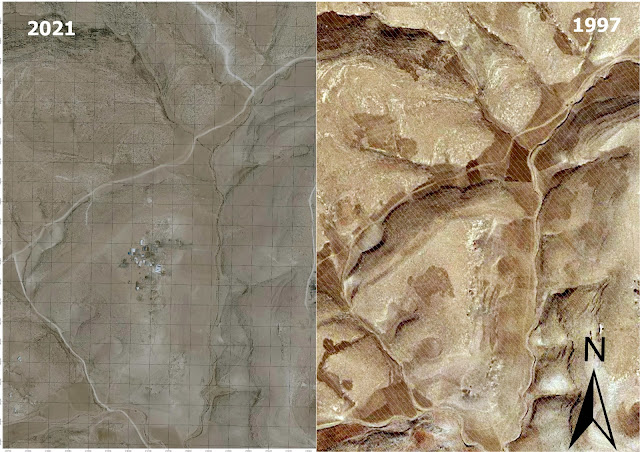The residents showed their own evidence of residency in the area in recent decades, and the Israeli High Court said that their photos were only showing evidence that there weren't any permanent structures there.
For the sake of example, our focus will be on the aerial photographs of "Khirbet al-Fahit" presented by the respondents ("al-Fahit" according to the petitioners). In 1967 and 1981 the area was completely empty of buildings. Some development is evident during the years 1990 and 1991. In 2001 it is evident that a number of buildings were already built in Kharbit, and such were built more and more in 2007, 2009, 2011 and 2012.
An identical picture is revealed from the aerial photographs attached by the petitioners and even more clearly. It can also be seen that in 1972 and 1981 there is no evidence of buildings in the area compared to 2011, when there is a lot of construction on the site.
The same is true with regard to Khirbet Hilweh ("Al Hilweh" according to the petitioners). There is not much room to doubt that in the early years (1967, 1979, 1981 and even 1991) there is no evidence of construction on the site. However in the years 2007, 2009, 2011 and 2012 more and more buildings and houses were built. There is a sharp and noticeable difference between the photos from the early period (in 1972, 1981 and even 1993) and the photo from 2011 in which construction can be clearly identified.
This is how these "villages" were born: The shepherds of Yatta, who lived in brick and mortar homes, would sleep in the natural caves in the grazing areas during certain seasons, rather than trekking back to the village each night. After the IDF closed off the area, the shepherds were permitted to continue to graze their flocks there; the IDF gave them a few days' warning before live-fire exercises to insure that no one got hurt. But the give-them-an-inch-and they'll-demand-a-mile dynamic soon set in, and the Palestinian Authority jumped in and began to fund construction and provide materials for permanent structures. Foreign interests funded infrastructure projects for the "indigenous farmers" - laying the water and electricity lines that enabled more and more people to set themselves up on the "free" land and build additional homes - all funded by European donations. This pattern was repeated all through the area; this was proven in the High Court of Justice - by the plaintiffs themselves!
But the IDF willingness to compromise meant that instead of dealing with the illegal construction early, they allowed it to become much more of a problem.
The first petitions regarding Masafer Yatta were filed over 20 years ago - by leftist organizations that tried to wrest control of the area out of the State's hands. There were temporary injunctions issued, which were not only ignored, they were trampled. Rather than tear down the few structures that had popped up in the firing zone, the IDF kept pulling back, limiting the area it used for training in order to avoid harming the squatters who, for their part, pulled out all the stops and poured massive resources into more and more construction and development. What started off as a few structures in contained areas metastasized into hundreds of structures, many hundreds of residents, and a brand new fake-news international humanitarian crisis. A full two decades passed before the High Court finally admitted what had been clear from the start, and what Regavim has been saying all along: The Arab claims to this land are fake news, the claim that Israel is dispossessing indigenous people is a lie - and the State of Israel has allowed its own delusions that it can compromise on our national interest to cause massive local and international damage.
The court decision also noted that the vast majority of petitioners still have homes in the places they moved from to grab this seemingly free land from the State of Israel. In other words, the claim that over 1000 Palestinians will be "homeless" is yet another lie. They have their original homes.
There are no indigenous residents of "Masafer Yatta." The land was always empty and the only reason anyone lives there today is because Palestinians are trying to steal all the previously empty lands they can and claim that they were always there.

 Elder of Ziyon
Elder of Ziyon

.jpeg)






![[Elder of Ziyon] Facebook may add "Insha'Allah" button for events](https://blogger.googleusercontent.com/img/b/R29vZ2xl/AVvXsEi9KIDYyRBYSDMD-x2PZwXZNYKl0eHCeNWbuEWt6IvsNL6IFhtZTpF2SvNRlui4o-nPTjPMcmSOxJ1nPo0pPGPzI5r7GHO_ZfKV9WUcNnkMeMslnkgWq0GeILJg-5vXLLCLckj6SUmdJqmc/s72-c/arabic_facebook_logo_by_ali_normal-d37tr0q.jpg)



0 comments:
Post a Comment